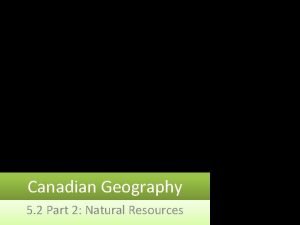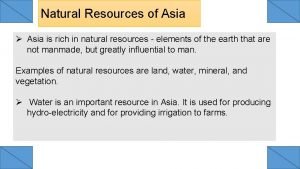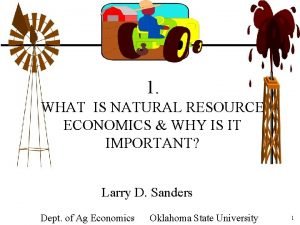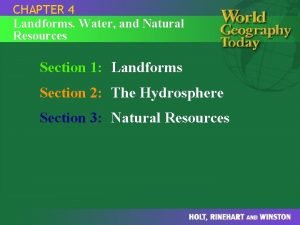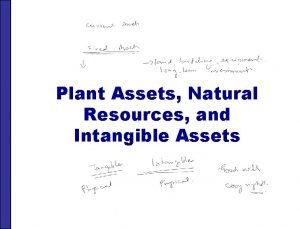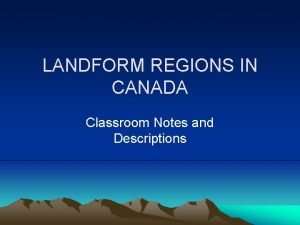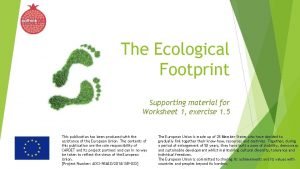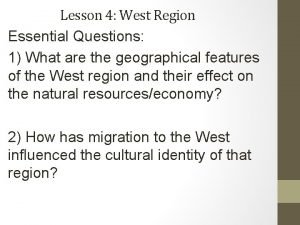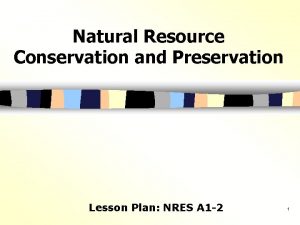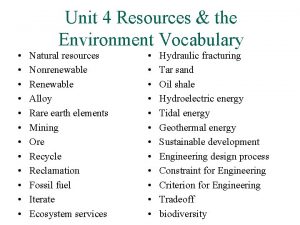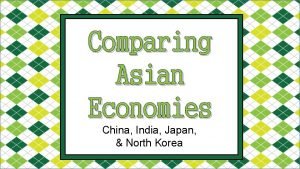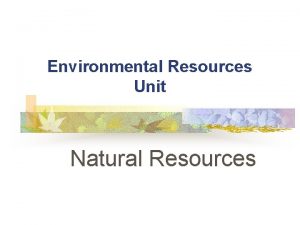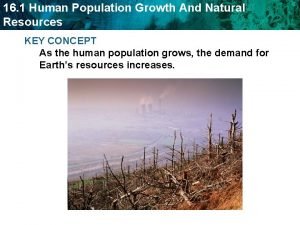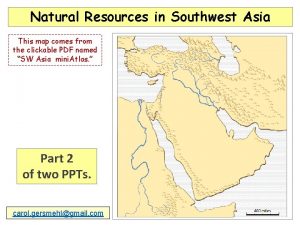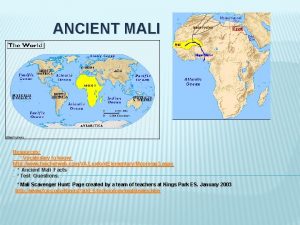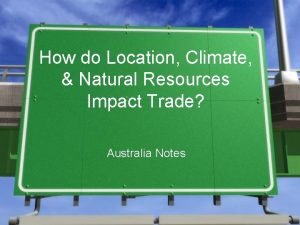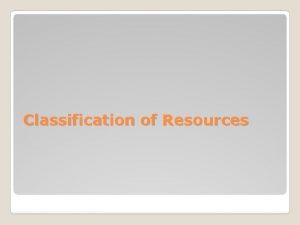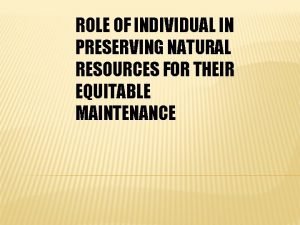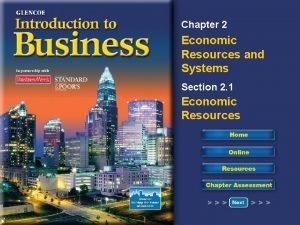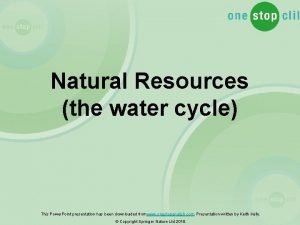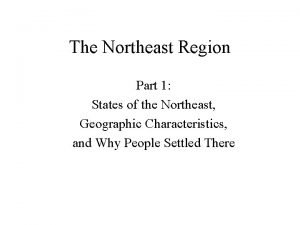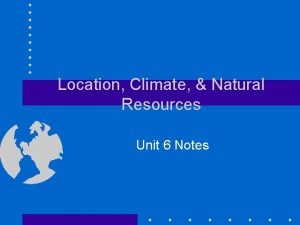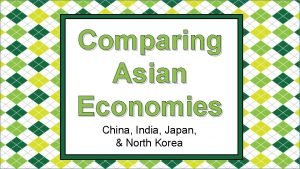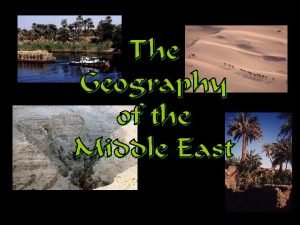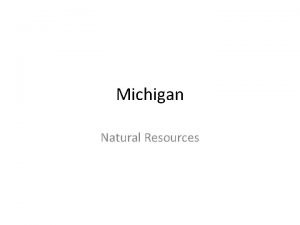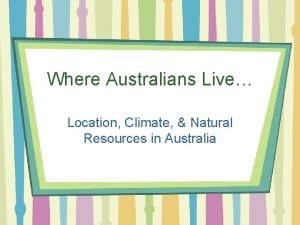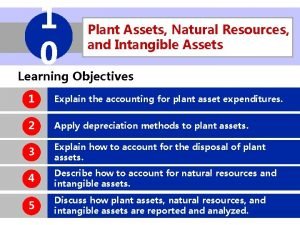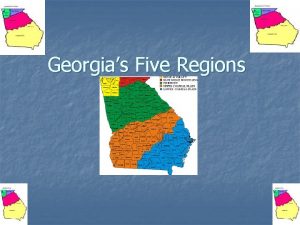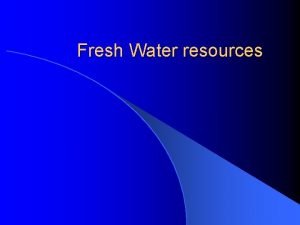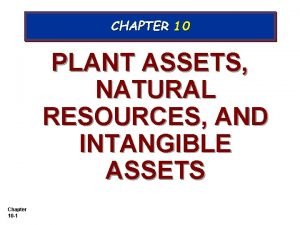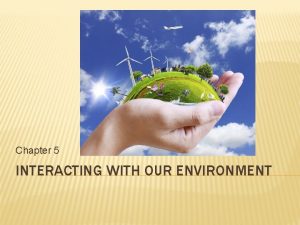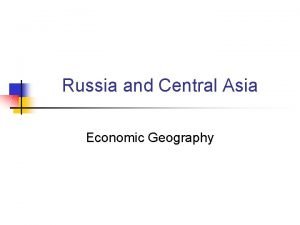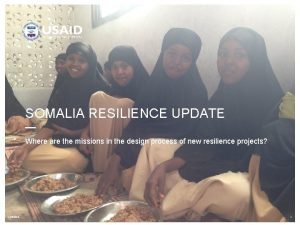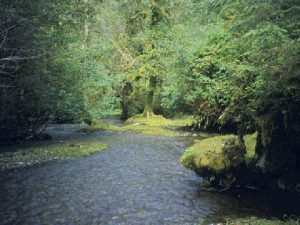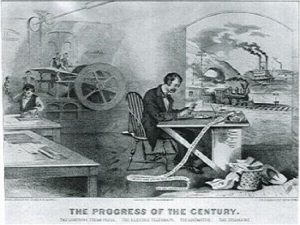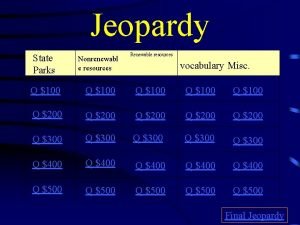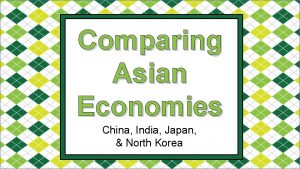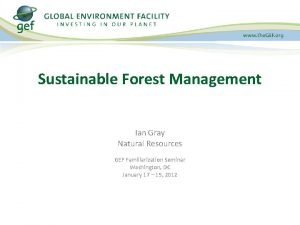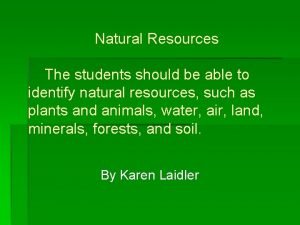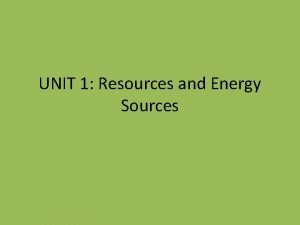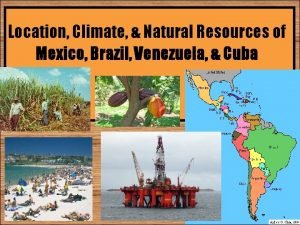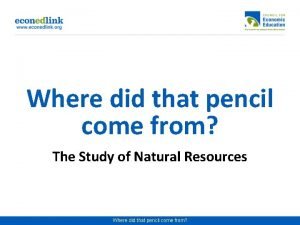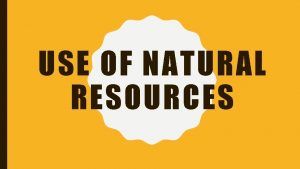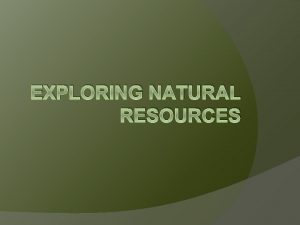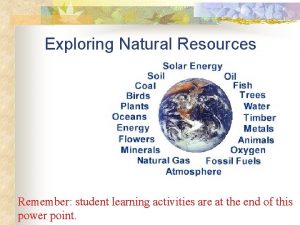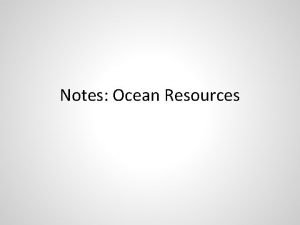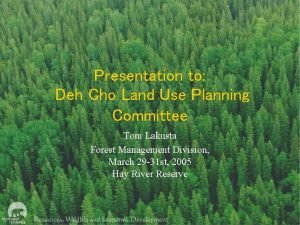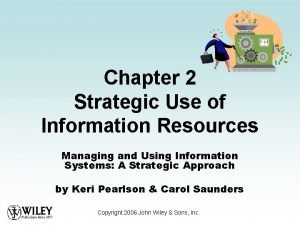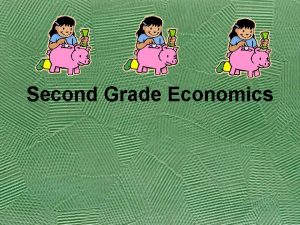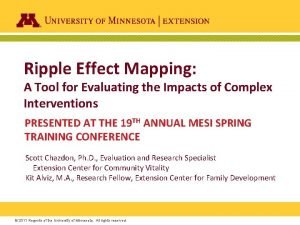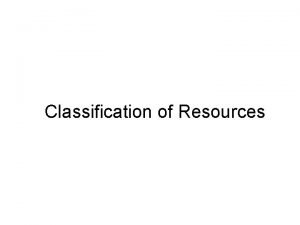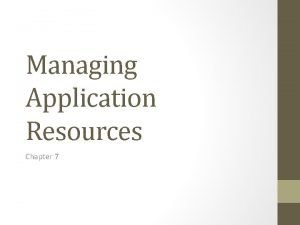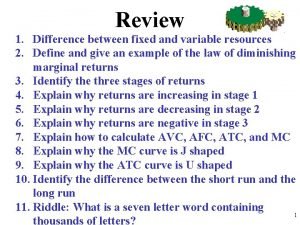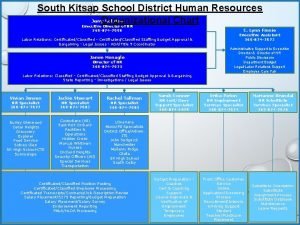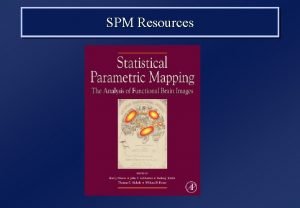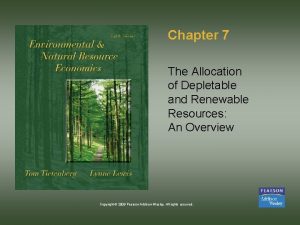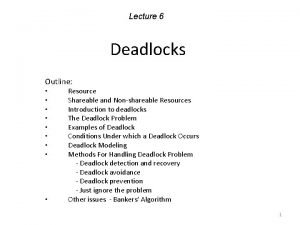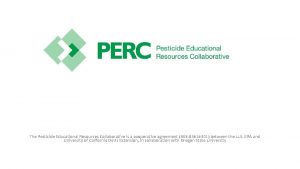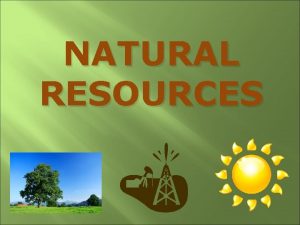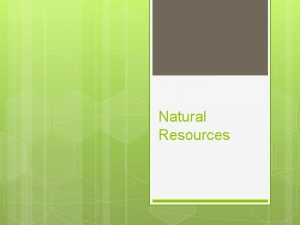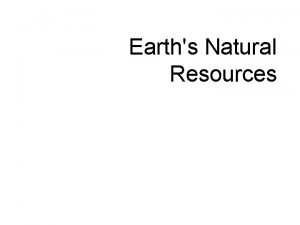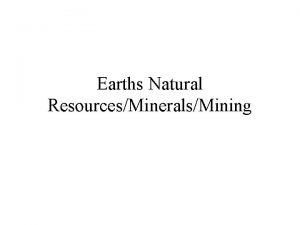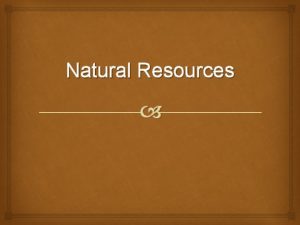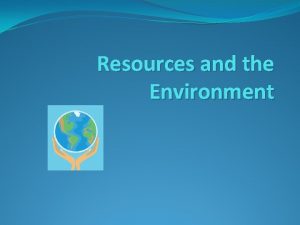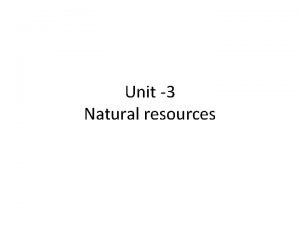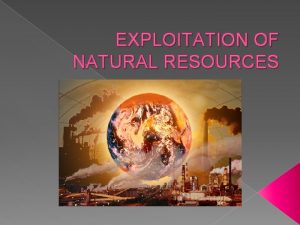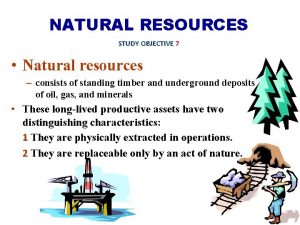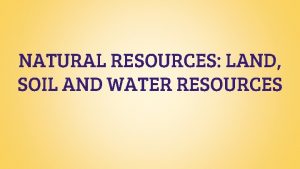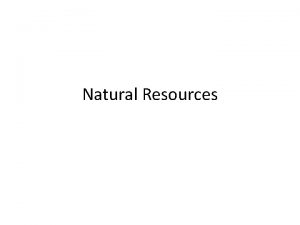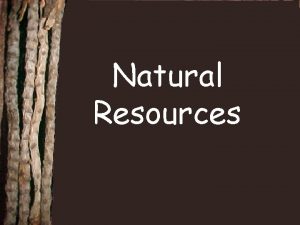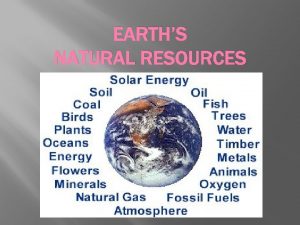MODULE 2 MODULE 2 NATURAL RESOURCES Natural resources





























































































- Slides: 93

MODULE 2

MODULE 2: NATURAL RESOURCES Natural resources are natural assets (raw materials) occurring in nature that can be used for economic production or consumption. Water, air, soil, minerals, forest, wildlife are all example of natural resources. Natural resources are divided into two broad category: Renewable resources: These resources have the capacity to regenerate themselves within a given span of time. For example plant and animal species have the capacity of reproduce so any loss due to natural or artificial causes can be replaced with the new one. Example of renewable resources are: Forest, wildlife, wind energy, tidal energy, solar energy, water energy etc. Non-renewable resources: For these resources generation time is too long, for example production of coal, mineral oil, mineral ores takes several thousand years, so if they exploited on large scale its not easy to replace them. Example of nonrenewable resources are: coal, petroleum, minerals etc. However renewable resources can also turn into non-renewable resources if the rate of exploitation or consumption exceeds their rate of regeneration. Examples: ground water depletion, extinction of plants and animals, fertile soil , forest.

Problem associated with natural resource: Overexploitation: leads to depletion and degradation of natural resources. Example: fish catch, ground water, forest Pollution: due to pollution resource usefulness reduces. Example: fresh water, soil Major Natural resource: Forest resource Water resource Mineral resource Food resource Energy resource Land resource

Forest resources: Are most important resource in term of providing material goods along with ecological services. Definitions: The Food and Agriculture Organization of the United Nations (FAO): forest which includes a minimum threshold for the height of trees (5 m), at least 10 per cent crown cover (canopy density deter mined by estimating the area of ground shaded by the crown of the trees) and a minimum forest area size (0. 5 hectares). The United Nations Framework Convention on Climate Change (UNFCCC): 0. 01 -1. 0 hectares for minimum area, 2 -5 meters for minimum tree height and 10 -30 per cent for minimum crown cover. MOEF: Forest cover in India is defined as all lands, more than one hectare in area with a tree canopy density of more than 10%.

World forest area:

How Are Forests Classified Climate: Temperature (e. g. boreal, temperate, subtropical, tropical) Moisture (rain forest, monsoon forests, dry forests) Seasonality: Deciduous vs. Evergreen Leafing Strategy: Broadleaved vs. Needle-leaved In total 28 type of forest class are present in the world. Tropical forest : Asia, Australia, South America, Africa, Pacific Caribbean Temperate: North America, Western and Central Europe, NE Asia Boreal: Eurasia, Siberia,

Forest cover in India: The total forest cover of the country (2007 assessment) is 690, 899 km 2 and this constitutes 21. 02 percent of the geographic area of the country. Very Dense Forest (tree cover of canopy density of 70% and above), Moderately Dense Forest (tree cover of canopy density between 40% to 70%), Open forest (tree cover of canopy density between 10% to 40%), Scrub (tree cover of canopy less than 10%)

Uses of Forest Resource: Forest resources are useful in term of goods (commercial and consumptive) and environmental services: Consumptive and commercial use: • Timber Extraction: Used for the construction, industrial uses, paper and pulp industry etc. Japan is the largest timber importer in the world and is responsible for the deforestation in tropical and temperate forest.

• Fuel wood and charcoal for heating and cooking purpose: Fuel wood still support the need of energy in rural part of India. • Fodder for cattle: India has the largest livestock population in the world, with 485 million head of livestock, many of them raised by small and marginal farmers who depend on grazing land to meet the fodder requirements of their animals.

• Minor forest produce (NTFPs): Forest are also an important source of NTFPs which play an important role in the livelihoods and resilience of rural communities and in some of India’s poorest regions, NTFPs contribute up to 60 percent of household income. ” NTFP included variety of items—animal products like hides, horns, silk cocoons, ivory; bamboo and about 3000 plant species even by official definition, including canes, drugs, spices, fibers, flosses, grasses, gums, resins and oleoresins, lac, tans, dyes, vegetable oils and oil seeds, leaves, minor minerals like mica, lime, shells etc. , and edible items. Environmental Services provided by Forest: • Production of oxygen: called as earth’s lungs. Produce oxygen during the photosynthesis process, which is vital for life on this earth. • Reducing global warming: green house gas CO 2 is absorbed by forest as a raw material for the photosynthesis. • Wildlife habitat : Homes of million of wild animal and plant. Tropical forest alone host 7 million species.

• Watershed Protection: reduce the rate of surface run-off of water, so prevent the flash flood and soil erosion and also ensure prolonged run-off so maintaining the water flow in streams and river. • Soil conservation: due to dense root mat in the forest system soil are strongly bind thus prevent their erosion due to wind or rain. In the costal areas mangroves protect land form erosion due to strong ocean current. • Pollution moderator: Forest have the capacity of absorbing toxic gases mainly VOCs and also can also absorb noise thus help in preventing air and noise pollution. • Aesthetic importance: Its lush green and pollution free environment make them a perfect tourist destination. Forests are now generating large amounts of revenue in various countries across the globe in response to the development of tourist industry. • Cultural and religious importance: Many of the tribal consider forests and its trees as abode of deities known as Sacred Grooves. They also worship trees and animals of forests. Thus, they are dependent on forests not only for their food and energy demands but also for the sustenance of their diverse cultural and religious beliefs. Example: Gumpa Forests in Sikkim and Arunachal Pradesh.

Problem associated with the forest resource: Over exploitation of forest resources: • Forest resource in India are over exploited due to which total forest cover area in India is lower than the required forest cover of 33%. • Very little Indian forest are pristine due to large scale human exploitation. Due to this exploitation tropical evergreen forest cover is now only reduced to Coastal western Ghat and Northeast India. Major causes: Increase in population: The population of India has grown from 361 million in 1951 to 846 million in 1991 and crossed the one billion mark on 11 th May, 2000 and would grow further to 1. 7 billion by 2050 as per the UN's long -range projections for India.

DECLINING PER CAPITA AVAILABILITY OF FOREST AREA IN INDIA: As the per capita area of forest decrease it deplete resource much faster

• Increase in urban and metropolis areas: As the number of city increase it increase the demand for the timber for construction and industrial purpose resulting into degradation of forest resource. • Increase pace of developmental project: After independence development projects such as road construction, Mining activity, thermal power plant were sanction in large number which also resulted into depletion of forest resource. Deforestation: Definition: United Nations Framework Convention on Climate Change 2001 defined as the direct human-induced conversion of forested land to non-forested land Food and Agriculture Organization 2001 The conversion of forest to another land use or the long-term reduction of the tree canopy cover below the minimum 10 percent threshold.

Causes of deforestation: • Shifting cultivation: Shifting cultivation, also referred to as forest agrarian system, has been widely practiced by hill communities in Asia, Africa, and Latin America since the Neolithic period (13, 000 to 3, 000 BC). The practice is characterized by a cultivation phase, which involves clearing of primary or secondary forest and crop cultivation for one to three years, followed by a fallow phase, during which cultivation is suspended to allow recovery of soil fertility. In India this practice is common in North-east, Andhra Pradesh, Bihar and Madhya Pradesh. • Growing Food needs: Conversion of forest land to agricultural land is major cause of deforestation in developing country. • Raw material for industrial use: with the increase in population demand for wood for making boxes, furniture, railway-sleeper, plywood, match-boxes, pulp for paper industry has increased. Overgrazing: illegal grazing and overgrazing in forest tracks has also been primarily responsible forest degradation in India's livestock population has increased from 228 million in 1951 to 336 million in 1992 and is projected to cross 500 million by the end of 2000.

Development projects: Massive destruction of forest occurs for various development projects such as hydroelectric projects, big dams, road construction and mining.

Major consequences of Deforestation: • Biodiversity loss: forest host large number of plant and animal and deforestation leads to their extinction due to habitat loss. • Loss of CO 2 sink: due to deforestation the stored carbon in the forest released into atmosphere which further enhance the global warming problem. • Watershed depletion: due to loss of forest area, risk of flash flood increases, it also reduces the amount of ground water recharge their by reducing the amount of fresh water. • Problem of soil erosion and loss of soil fertility increases due to loss of forest area. Case studies: Desertification in Hilly regions of the Himalayas Disappearing tea garden in Chhota Nagpur Waning rainfall in Udhagamandalam (Ooty)

Forest (conservation) Act, 1980 This act was formulated to check indiscriminate dereservation and diversion of forest land to non- forest purpose. The main point in this act: • Prior permission from central government before any forest land is diverted to non-forest purpose. • If diversion is permitted, compensatory afforestation is insisted upon. If non-forest land is available then afforestation be raised over equivalent area of non forest land. In case of non-aviability of non-forest land plantation will be done degraded forest twice in extent of diverted land. Amendment in 1988 for including stricter panel provision against violators Joint Forest Management (JFM): National forest policy of 1988 formulated the JFM, where local village community and the forest department work in co-ordination to protect and conserve forest resource. In the guideline issued in 2000 by MOEF, at least 25% of income from the area must go to the community. Until 2002, there were 63, 618 JFM committees managing over 140, 953 sq km of forest in 27 state in India.

Social forestry: It includes • Creation of woodlots in the village common land, government waste land panchayat land (estimated at least 12 mha) • Planting trees on the side of roads, canals and railways (1 mha) • Afforestation of degraded government forest in close proximity to village (10 mha) • Planting of trees on and around agricultural boundaries and on marginal, private lands, constituting farm forestry, or agro-forestry(143 mha).

Water resources: Water is an indispensable natural resource on which all life depend, about 70% of earth surface is covered with water and most of the animal and plants have 60 -65% water in their body. Distribution of water on earth surface:

Water: a unique resource Water is characterize by certain features which make it a marvelous resource: exist as a liquid over a wide range of temperature i. e. from 0°C to 100°C. High specific heat, due to which it warms up and cool down slowly without causing shocks of temperature jerks to the aquatic life. Water is called the "universal solvent" because it dissolves more substances than any other liquid. It can serve as a very good carrier of nutrient which are essential for the aquatic biota. Due to high surface tension and cohesion , it has the capillary effect which help it in the movement through great heights through the trunk of the tree. As it freezes, its density become lower. Being lighter ice keeps floating , whereas the bottom water remains at a higher temperature and therefore, can sustain aquatic organism even in extreme cold.

Hydrological Cycle: Earth's water is always in movement, and the natural water cycle, also known as the hydrologic cycle, describes the continuous movement of water on, above, and below the surface of the Earth.

Water Uses: Water is used for drinking, irrigation, transportation, washing and waste disposal and as coolant for thermal power plant and other industries. World water use India water use

Type of water resource: Ground water: Groundwater is the major source of fresh water and usually considered as more clean the surface water however in recent decade fertilizer and pesticide originating from the agricultural lands and heavy metal from landfill sites are major ground water pollutant. Ground water are mainly withdraw from aquifers. Aquifers: derive from Latin words, "Aqua" (water), and "fer" (to carry). An aquifer is a sub-surface geologic formations (solid rock and/or unconsolidated sediments) that contains ground water in sufficient quantities to be used, or have the potential to be used, for drinking water supply or for commercial, industrial or agricultural purposes. Three type of aquifers are their: Unconfined aquifer: Overlaid by permeable earth materials and they can be recharged by water seeping down from above in the form of rainfall or snow melt. Confined aquifer: are confined between two impermeable layers of rock or sediment and are recharged only in the those areas where the aquifer intersect the land surface. Perched aquifer: water get trapped between impermeable structure, no recharge takes place in these aquifer.


Effects of overexploitation of Ground water: Subsidence: When the rate of withdrawal is more than its recharge rate, the sediment in the aquifer get compacted and results into the ground subsidence. Examples: The north china plains, Farrukhabad district , U. P. Lowering of water table: Lowering of water table in semi-arid and arid region due to overexploitation and lower recharge rate is very common phenomenon. Example: Delhi and Punjab region showed lowering of ground water level. Sea water intrusion: especially occurs in costal areas, where salt water front move further in land due to excess pumping of ground water. Costal area of Gujarat and Tamil Nadu faces this problem. Low supply to river and wetlands: Ground water is important source of water to the perennial rivers especially in the non-monsoon season, overexploitation results into lowering of water table thus reducing the supply of water to river or wetland areas. Water logging and salinity: common problem in intensive agricultural areas, where farmer applied excess water on the land results into raising of water table and subsequently water logging and increase salinity. Occurs in Punjab regions.

Surface water: The part of precipitation which does not percolate down or get evaporated to atmosphere forms the surface water mainly in the form of stream, lake, ponds, wetlands or artificial reservoir. It serves multiple purpose such as provide water for domestic, industrial and irrigation purpose, navigation and electricity generation, provide habitat for aquatic species. Availability of surface water resources depends upon two precipitation phenomenon: Floods: Most of the rainfall is concentrated into 4 months of monsoon season characterize by heavy rainfall resulting into increased river discharge sometime exceeding the capacity of river channel to hold such amount of water which cause the flooding of floodplain and nearby areas. As per the Geological Survey of India (GSI), the major flood prone areas of India cover almost 12. 5% area of the country. In India major flood prone area are categories into: Ganga Basin: West Bengal, Bihar and Uttar Pradesh are mainly prone to flood every year. Main river basins are: Ganga, Rapti, Gandak, Ghagra, Mahananda, Bhagirathi, Damodar, Bagmati, Gandak, Kamla etc. Brahmaputra and Barak Basins: West Bengal, Assam and Sikkim. Main river basins are Brahmaputra, Barak, Jaldakha, Teesta and Torsa river etc.

Central India and Deccan Rivers Basin: Andhra Pradesh, Odisha and Tamil Nadu. Main river basins are: Narmada, Godavari, Tapi, Krishna and Mahanadi. Flood Prevention Structural Measures: 1) Construction of Embankments and levees. Watershed Management Artificial reservoir through dam construction Non Structural Measures: Flood Plain Zoning: Flood Forecasting and warning

Droughts: Drought may be defined as an extended period – a season, a year or more – of deficient rainfall relative to the statistical multi-year average for a region. Type of Drought: Metrological drought: According to the India Meteorological Department (IMD), meteorological drought occurs when the seasonal rainfall received over an area is less than 75% of its long-term average value. Agricultural drought: insufficient soil moisture to meet the needs of a particular crop at a particular point in time. Hydrological drought: deficiency in surface and sub-surface water supply. It is measured as stream flows and also as lake, reservoir and groundwater levels. Causes of Drought: 1) Erratic rainfall during monsoon: The southwest monsoon denotes the rainfall received between the months of June and September and accounts for around 74% of the country's rainfall. 2) Reckless over-exploitation of surface and groundwater: for agricultural areas results into drought like situation. Selection of high water requiring plants such as sugarcane also resulted into drought into many part of Maharashtra.

3) Deforestation: Deforestation leads to drought as forest protect the watershed thus ensures greater availability of water, less soil erosion, more rainfall, flood and landslide control, etc. 4) Climate change: Climate change also aggravate the problem of drought due to increases uncertainty in the monsoon pattern due to frequent occurrence of El Nino events. Consequences of Drought: Impact on crop production: Drought has detrimental effect on the crop production. Food grain production dipped by 29 million tonnes to 183 million tonnes in 2002. (212 million tonnes in 2001). Impact on water resources: In nine of the 10 drought-affected states, over 50% of wells experienced a drop in groundwater levels. It also affects the water availability in the surface reservoir for useful purpose. Impact on cattle and fodder: Water and fodder shortages during a drought situation cause considerable stress to small and marginal farmers, as they own a bulk of the bovine population. Impact on the power situation: Hydroelectric power stations contribute 25% of the total power generated in the country (2001), a fall from 41% in 1961. Any stress on the water situation, as in a drought, can have serious consequences, especially in states already battling a power deficiency.

Mitigation measures for droughts: 1) Development of early warning and expert systems: By using modeling to predict monsoon behavior and also to measure available water resource in a particular area. 2) Integrated watershed management rainwater harvesting: for proper management of water resource and to increase available pool of water for useful purpose. 3) Soil and crop management approaches: proper soil conservation methods to stop soil erosion and nutrient management with suitable agricultural and irrigational practice such as crop rotation, drip irrigation methods. Some examples: Ralegan Siddhi: villagers built check dams and tanks. To conserve soil they planted trees. The result: from 80 acres of irrigated area two decades ago, Ralegan Siddhi has a massive area of 1300 acres under irrigation. 2) Tarun Bharat Sangh: The work of Tarun Bharat Sangh, and it's founder Rajendra Singh in the districts of Rajasthan can easily be over-simplified as water-shed management whereas, it is in fact a revolution in regenerating life and society in denuded and deserted lands.

Water resource dispute: Water resource especially surface water sources such as rivers often cross more than one nations or states giving rise to dispute related to its distribution. Some of the major disputes are: Water conflict in the Middle east: Mainly related to the distribution of three major river basins, name Jordan, Tigris-Euphrates and Nile between different middle east countries. The Indus water treaty: In 1960, sharing of water from Indus river basin between India and Pakistan, where Indus, the Jhelum and the Chenab were allocated to Pakistan and Satluj, the Ravi and the Beas were allocated to India-Bangladesh water disputes: Construction of Farakka Barrage in 1974 over Bhagirathi river causes dispute between India and Bangladesh over sharing of Ganga water. Cauvery water dispute: dispute between state of Karnataka and Tamil Nadu over sharing of Cauvery water resulted into formation of Cauvery water Dispute tribunal in 1990. The Satluj-Yamuna Link canal Dispute: Between Punjab and Haryana for sharing the Ravi-Beas waters, and case is now in Supreme court. Mullaperiyar Dam: recent controversies between state of Kerala and Tamil Nadu over Mullaperiyar Dam over Periyar river.

Traditional water Management System: Neerkatti: In South India, they manage the water system my using tradition tank system. They are the people responsible for the distribution of water to the agricultural land. Havaldars or Jaghyas: In Maharashtra, they manage and resolve involving conflicts by overseeing the water channels from main canal to the distributory canal. Churpan: water manager in the Ladakh region have the power to allocate available water resources. irrigation of rice terraces with bamboo pipes: water is transported through an intricate system of Bamboo pipes to agriculture fields in the Arunachal Pradesh. DAMS (Benefits and Problem): Described as 'New Temple of Resurgent India' by Jawaharlal Nehru Dams are usually considered to play a key role in development process due to their multiple uses, however Dams are also associated with the multiple environmental and social problems:

Benefits of Big Dams: Increase availability of water for domestic and irrigational purpose especially in the regions of water deficits. Example: Irrigated land increased from 22. 6 million hectares (ha) in 1951 to about 89. 6 million ha by 1997, marking a fourfold growth over a period of 50 years. Electricity generation: Hydroelectricity account for 25% of total electricity generated in India. Dams store water during peak discharge period and release it during the low flow period thereby mitigating the risk of floods and drought. Construction of dams facilitate in-land navigation by maintaining river flow. Employment generation for the local population during the construction and maintenance of dam. Site for recreational activity and tourist spot for examples Bhakra Dam, Tehri Dams are major sites for tourist attraction.

Problem associated with Dams: 1) Biodiversity loss: submergence of large areas of land due to construction of reservoir leads to loss of forest, flora and fauna of the area. 2) Displacement of tribal and local area: Dams construction results into displacement of local population residing in that area, and resettlement of these displaced people are one of the major problem. In India approx. 16 to 38 million people displaced due to construction of large Dams. 3) Fragmentation and physical transformation of river system. 4) Change in the migratory route of Fish thereby reducing the total fish population in the river system. 5) Capturing of the silt and sediment on the upstream side of dams results into fertility loss in the flood plain in the down stream areas. Example: Aswan dam on Nile river. 6) Increase risk of seismicity associated with the dam construction. Example: Koyna Dam in Mahrastra. 7) Risk of flash flood due to bursting or leakage of dams. Example Panshet dam burst near Puna.

Case studies: 1) Sardar Sarovar Project: This dam is constructed on Narmada River, in Gujarat.

Mineral resources Any mineral, element, and rock that can be extracted from the ground and it has a potential value. "Minerals are naturally-occurring inorganic substances with a definite and predictable chemical composition and physical properties. " (O'Donoghue, 1990). Usefulness of mining resources: Building Materials: sand, gravel, stone, cement, steel, aluminum, asphalt, glass. 2) Plumbing and Wiring: iron and steel, copper, brass, lead, cement, asbestos 3) Appliances: iron, copper, many rare metals 4) Defense equipments 5) Agricultural: fertilizers, machinery 6) Transportation means 7) Jewelry: gold, silver, platinum, diamond etc.

Type of Mineral resources: Non- metallic minerals: e. g. graphite, diamond, quartz, feldspar Metallic minerals: bauxite, laterite, haematite etc. Fossil fuels (also known as mineral fuels): the organic mineral substances that can be utilized as fuels, such as coal, petroleum, natural gas etc. The minerals and their ores need to be extracted from the earth’s interior and the process of mineral extraction is known as mining process. The mining process involves following stages: Prospecting: This is done for the searching of minerals. The searching methods includes direct analysis of minerals outcrops combined with the aerial photography, geologic maps, and structural assessment of an area. In case of indirect analysis use of geophysical methods such as gravitational, seismic, magnetic, electrical, electromagnetic, and radiometric variables of the earth. 2) Exploration: determines as accurately as possible the size and value of a mineral deposit, utilizing techniques similar to but more refined than those used in prospecting.

3) Development: It involves work of preparing access to the deposit so that the minerals can be extracted. This process involves acquiring water and mineral rights, buying surface lands, arranging for financing, and preparing permit applications and an environmental impact statement (EIS). 4) Exploitation: It involves actual extraction of minerals from the mines. 5) Reclamation: the process of closing a mine and recontouring, revegetating, and restoring the water and land values. Depending upon the ways of exploitation mines are divided into two parts: Surface mining: Open pit or open cast mining is usually employed to exploit a nearsurface deposit ore. . It often necessitates a large capital investment but generally results in high productivity, low operating cost, and good safety conditions. 2) Sub-surface mining: mainly involves unsupported, and caving type of mine used for mining deep minerals deposits. It is most destructive, dangerous, expensive including risks of occupational hazards and accidents.

Waste associated with mining activity:

Ore processing: Ore processing is a set of operations used to separate the mineral phases containing the useful substances from the waste gangue; the product of the plant, enriched with useful materials, is called the "concentrate". This processing can be physical and physicochemical methods such as gravity separation and flotation. It can be biological such as bioleaching or chemical such as cyaniding( addition of sodium cyanide solution to extract gold from ore) in gold ore processing. Waste generated during ore processing are known as tailings (processing waste); which can include: Aqueous solutions from cyaniding. Slurries of finely ground particles that have undergone or more types of physical or chemical treatment, and which frequently contain one or more industrial additives that have participated in the conversion process (xanthates, salts, starch, etc. ). These tailings are normally dumped in a sort of lagoon or settling basin within an embankment at the exit of the mill. Atmospheric releases from sulphide roasting including sulfur dioxide gas which is a agent for acid rain.

Indian mineral resources: India has rich mineral resource especially for metallic minerals such as iron ores, manganese, chromite and titanium. It has world largest reserves of mica and bauxite. India is the producer of 84 minerals the annual value of which is about 50, 000 crore. Some of the major mineral resource are: Energy generating minerals Coal and Lignite: West Bengal, Jharkhand, Odisha, Madhya Pradesh, Andhra Pradesh. Uranium: Jharkhand, Andhra Pradesh, Meghalaya, Rajashthan Other commercial used minerals Aluminum (Bauxite ore): Jharkhand, West Bengal, Maharashtra, Madhya Pradesh, Tamil Nadu Iron (hematite and magnetite ore): Jharkhand, Odisha, MP, AP, TN, Karnataka Copper (Copper pyrites) : Rajasthan, Bihar, Jharkhand, MP, WB, AP and Uttarakhand

Some of the major mines in India and associated problem: 1) Jaduguda uranium mine, Jharkhand: Operation started in 1968 and the present capacity of mine is to extract and process 2090 metric tonnes per day (MTPD) capacity. It exposing local population of 50, 000 to the risk of radioactive hazards. 2) Jharia coal mine, Jharkhand: Total area of 450 sq km out of which 4% of area is affected by underground fire which leads to land subsidence and displacement of people. 3) Sukinda chromite mines, Odisha: Total area of 200 sq. km. , these mines provides 97% of total chromite ore reserve of country. Presence of hexavalent chromium ion in mine drainage water severly affect the aquatic ecosystem of the mining areas. It is cytotoxic, mutagenic and carcinogenic. 4) Kudremukh iron ore mine, Karnataka: The operation of Kudremukh iron ore company limited in western Ghat mountain range have caused large scale destruction of hill, pollution of surface and ground water and severely affected the kudremukh national park. 5) North-Eastern Coal fields, Assam: Mining for the coal started in 1882. The ground water and surface water sources are affected by acid mine drainage and high sulphur contamination.

Environmental problem associated with Mining: Devegetation and defacing of landscape: Top soil along with vegetation has to be removed for reaching to the mineral resource, this results into removal of forest and vegetation present in the area also results into loss of biodiversity. Subsidence of land: mainly related to the underground mining often leading to destruction of property and displacement of local habitants. Watershed disturbance: Mining activity disturb the natural hydrological process and pollute the ground water due to leaching of heavy metals and acids. Acid-mine drainage: Acid mine drainage is most serious problem associated with the mining sectors. This is normally associated with the metal ore mines and coal mines having high concentration of sulphides in ores which react with air and water to produce acidity. Air Pollution: Mining activity is also a major source of SPM, some of the coal mines release methane through cracks and opening. Mine fire also results into formation of NOx and SOx and some secondary pollutant such as ozone. Noise pollution: Mining activity involves lot of heavy machinery related to extraction and transportation of mineral ores resulting into increase noise level in the mining zones.

7) Displacement of tribal and local population: Mining activity in forested and hilly region mostly resulted into the displacement of tribal and marginalized population resulted into their rehabilitation issue. 8) Occupational hazards: Mining activity especially underground mining is associated with greater risk for the worker due to occurring of mine accidents involving collapse of mine wall, flooding of mines or mine blast associated with methane. Beside accidents longs working in the mine environment results into diseases such as asbestosis, silicosis, black lung disease etc. Case studies: Mining in Sariska Tiger Reserve in Aravallis.

Food Resources • Food is a critical need for survival of living being and is required for growth, physical and mental ability and good health. Any substance containing nutrients, such as carbohydrates, proteins and fats that can be ingested by a living organism and metabolised into energy and body tissue. • Different sources of food resource: • Plant food: It includes cereal grains, vegetables, fruits, nuts, sugar, fats and oils. Among cereal grain rice, wheat and maize are the major grains. Rice and wheat are the staple food for the 4 billion people in the developing countries. • Animal food: The most preferred animal food by humans is mutton, beef, pork and poultry as well as their by-products (milk and eggs). • Fish and sea foods: It supports 70 million metric tons of high quality protein to the world diet. Requirement of food resource: Average minimum Calories intake on global scale = 2500 calorie/days < 90% of this value = undernourished < 80% of this value = serious undernourished

World Food Problem: Every year 40 million people (50% of which are young children in the age group of 1 to 5 years) die of undernourishment and malnutrition. (13. 6% of world population)

Unequal dietary pattern in the world:

Indian Scenario: The Indian economy is predominantly agrarian. Agriculture constitutes 33% of our GDP, supports 64% of work force and earns 19% of our exports. India is the world’s second largest producer of food, next to China and has the potential of being the biggest in the world.

However 300 million Indians are still undernourished. India is home to 40 percent of the world’s malnourished children and 35 percent of the developing world’s low-birth-weight infants. Reason behind such scenario: Wastage of food grains: A Food Ministry report reveals that India wastes food worth over Rs 500, 000 million in a year, even as one fifth of its population is underfed.

Environmental problem associated with food resources: Environmental problem associated with food resources are associated with the production of food resources either from agriculture, cattle and poultry breeding and harvesting of fish and other aquatic products. Agricultural: Initially agricultural practice were less energy intensive with lower chemical inputs in form of fertilizers and pesticides. However with growing needs of food production agriculture become more energy intensive with more chemical inputs leading to degradation of water and land environment. Main problem associated with the modern agricultural are: Monoculture: most of the high yielding variety (HYV) encourage monoculture i. e. use of same genotype over vast area, so if there is an attack of pathogen, large tract of agricultural crop is going to affected. Fertilizer related problem: Application of fertilizer into agricultural land has variety of unwanted environmental affects such as: Micronutrient imbalance: Most of the applied fertilizer have micronutrient (N, P, K), which promote the growth of crop however during crop growth it also required micronutrient such as zinc which is not replenish resulting into the imbalance of soil nutrient.

• Nitrate pollution: nitrogen applied in the agricultural field find its ways to ground water and surface water in the form of nitrate which is a water pollutant. High concentration of nitrate results into methaemoglobinemia (Blue baby syndrome). • Eutrophication of the inland coastal ecosystem: Excessive supply of phosphate and nitrate from the agricultural land to water bodies result into the favorable growth of non-siliceous alga which are unpalatable resulting into their bloom which eventually consume all the oxygen present in the water bodies resulting into death of other aquatic species and destruction of whole ecosystem. 3) Pesticides related problems: different types of pesticides are applied to control crop from pest such as DDT(Dichlorodiphenyl trichloroethane), however their application also had some adverse effects: • Pest resistance and origin of new pest variety: After the time course resistance variety of pest started to arrived which make the application of pesticides unfruitful. • Death of non-target organisms: some of the insecticides are poisonous and not only kill the target pest but also other non-target species which are useful. • Biological magnification: some of the applied pesticides are non-biodegraded and keep on accumulating in the food chain a process known as biological magnification. It create problem for the species which are present on the higher level of food cahin.

4) Water logging: mainly occurs due to faulty irrigation practice, where land is flooded with water, however inadequate drainage leads to accumulation of water and rise in the water table which results into problem in root respiration and resulted crop yield loss. 5) Salinity problem: land salinity is the major problem and in total 1/3 of the total cultivated land is affected by salinity. Salinity arises due to accumulation of soluble salts such as Na. Cl, Na 2 SO 4, Ca. Cl 2 etc. The main reason behind the salinity is use of ground water for the irrigation purpose, which has high TDS compare to rain water. b) Livestock farming: Livestock provide food resource in form of meat, milk and eggs. However livestock farming also create problem such as: Overgrazing: livestock population graze over the community land, degraded forest land for their food supply which resulted into increase risk of soil erosion, land degradation and loss of useful species. Emission of greenhouse gases: Livestock sector is responsible for 9% of CO 2, 65% of N 20 and 37% of methane production due to human induced activity. Water pollution: waste emerging out of cattle farm are rich in organic waste, nitrogen and phosphate resulted into increase risk of eutrophication of inland water bodies.

Fisheries as food resources: It is a major food resource however it is suffering from the overexploitation which resulted into decrease in the fish catch amount and total productivity.

Energy Resources Energy is used for domestic purpose, agricultural purpose, production of industrial goods and for the transportation purpose. In fact per capita energy consumption indicates the development of any country.

Rate of world energy uses in terra watts. Growing energy demand: The demand for the energy resources are increasing due to increasing population and increased pace of development in developing country especially India and China. Between 1950 and 1990, the world’s energy need increases four folds. Year (1965 -2005)

Source of energy: A source of energy is one which provide adequate amount of energy in a usable form over a long period of time. It is divided into two major type: Renewable resource: it can be regenerated continuously in nature and are inexhaustible: examples: wood, solar, wind, tidal, hydropower, biomass energy, bio-fuel, geothermal energy and hydrogen. Non-renewable resource: it include resources which accumulation in nature take place over a long span of time and once exhausted cannot be quickly replenished. Examples: coal, petroleum, natural gas, and fuels like uranium and thorium. Renewable Energy resource: a) Solar energy: The source of solar energy is the nuclear fusion reaction taking place in the sun where lighter hydrogen atom combine to form heavier helium atom. The luminosity of the Sun is about 3. 86 x 1026 watts. This is the total power radiated out into space by the Sun. Most of this radiation is in the visible and infrared part of the electromagnetic spectrum, with less than 1 % emitted in the radio, UV and X-ray spectral bands. The power of the sun at the earth, per square metre is called the solar constant and is approximately 1370 watts per square metre (W m-2).

The energy of sun is harnessed from long time especially for drying purpose like seeds, clothes etc, however recently special instruments are use to harness the solar energy. Some of such instruments are: 1) Solar cell: also known as photovoltaic cells or PV cells are made up of semiconductor material like silicon and gallium. This material is dope with Boron or Phosphorous to generate N and P region to create an electric field. As the solar light absorbed in the cell and electron get released which then follow the electric field and generate the electricity. It is pollution free electricity generation process, however due to the high cost of raw material and variability of sun intensity it is not much popular yet. Mainly used in calculator, electronic Watches, street light, traffic signal, water pumps etc.

Solar cooker: mainly used for the cooking food and boiling water. It is mainly of three design: heat-trap boxes, curved concentrators (parabolics) and panel cookers. Food cooks best in dark, shallow, thin metal pots with dark, tight-fitting lids to hold in heat and moisture. Solar power plant: Solar energy is harnessed on large scale by using concave reflector which cause boiling of water to produce steam. The steam turbine drives a generator to produce electricity. Example: 50 K Watt capacity solar power plant has been installed at Gurgaon.

Solar water heater: Solar heat is used to warm water by conversion of light into heat energy. Solar furnace: A solar furnace is a structure used to harness the rays of the sun in order to produce high temperatures. This is achieved by using a curved mirror (or an array of mirrors) acting as a parabolic reflector to concentrate light (Insolation) on to a focal point. The temperature at the focal point may reach up to 3, 000 degrees Celsius, and this heat can be used to generate electricity, melt steel or make hydrogen fuel.

Wind energy: Utilized Kinetic energy of wind to generate electricity. The energy is harnessed by making wind mill. A large number of wind mill installed in cluster called wind farm. The wind energy potential of our country is estimated to be about 20, 000 MW , while at present we are generating about 1020 MW. The largest wind farm of our country is near Kanyakumari in Tamil Nadu generating 380 MW electricity.

Advantage of Wind power: Pollution free source of energy. According to EPA estimates, running a 1 MW wind turbine for one year eliminates the following pollutants from entering the atmosphere: 1500 tons of carbon dioxide, 6. 5 tons of sulfur dioxide, 3. 2 tons of nitrogen oxides, and 60 pounds of mercury. Required little maintenance cost after the installation. Limitation of wind power: The power produced by a turbine is proportional to the wind velocity cubed. This means, at low wind speeds (i. e. 4 m/s), there is a significant drop-off in the power produced versus moderate wind speeds (i. e. 7 m/s). T he power produced is proportional to the swept area that mean it is proportional to the blade length squared. The wind farms are the source of noise pollution and also results into bird deaths due to bird strike on rotating wind mill blade. Mainly useful in the costal areas with high wind speed. High cost of per unit electricity compare to electricity generated from fossil fuels.

Hydropower energy: A hydraulic turbine converts the energy of flowing water into mechanical energy. A hydroelectric generator converts this mechanical energy into electricity. The operation of a generator is based on the principles discovered by Faraday. The present installed capacity of Hydropower as on 30 -06 -2011 is approximately 37, 367. 4 MW which is 21. 53% of total Electricity generation in India.

Advantages to hydroelectric power: Fuel is not burned so there is minimal pollution. It plays a major role in reducing greenhouse gas emission. Relatively low operation and maintenance cost for hydropower. It's renewable - rainfall renews the water in the reservoir, so the fuel is almost always there. Disadvantages to hydroelectric power: disadvantage of hydropower is related to the construction of Dams which resulted into inundation of land wild life habitat. Power supply depend upon the Hydrology (precipitation) so variation in rainfall event will affect the power generation. Dam construction affects the quality of reservoir and stream water. Displacement of local population.

Tidal energy: Ocean tides produced due to gravitational pool of sun and moon on earth surface. The energy is harnessed by using the difference in high tide (high water level) and low tide (low water level) in ocean. This energy is harnessed by constructing tidal barrage in costal areas such as bay and estuary. During high tide ocean water enter into the barrage reservoir and turn the turbine attached to produce electricity. In case of low tide, sea level is lower so water stored in the reservoir move out to ocean and again turn the turbine. High tide Low tide

Advantage of Tidal energy: Environmental friendly method of energy generation with no pollution emission. Tides are more predictable and can be predicted years in advance so reliable source of energy. Barrage construction help in protection against floods in costal area and also help in the transportation. Disadvantage of tidal energy: 1) Only few suitable sites are present in world for harnessing the tidal energy. In India, two sites Gulf of Camby and Gulf of Kutch are producing tidal energy. 2) High capital cost and intermittent power generation takes place. 3) Change in the estuary ecosystem due to construction of barrage. 4) Accumulation of silt in the barrage which may accumulate pollutant.

Ocean Thermal Energy (OTE): The surface ocean layer is more warmer than the deeper ocean layer in the tropics and this temperature difference is used to generate electricity in Ocean thermal energy conversion power plant (OTEC). Minimum temperature difference should we 20°C or more for the OTEC power plant to work. OTEC system works as a heat engine with a low boiling point working fluid such as ammonia, which work between two temperature of deep and surface water. The working fluid circulate in the closed system taking heat from warm surface water and evaporated to run turbine and generate electricity and discharging heat to the cold water by help of heat exchanger. So it is a continuous electricity generation process.

Geothermal energy: The term geothermal comes from the Greek geo, meaning earth, and therme, meaning heat, thus geothermal energy is energy derived from the natural heat of the earth. The source of heat can be due to the fission of natural radioactive material present in rocks or molten lava come into contact of water reservoir. High temperature and high pressure stream fields are present below earth surface in many parts. In some part this high temperature streams come out naturally over the surface through cracks in the form of natural geysers such as Manikaran, Kullu and Sohna Haryana. Some time pipe has to drill through rock to bring this hot water on surface which in turn run turbine to produce electricity.

Biomass energy: Biomass is the organic matter produced by plant and animal in the form of wood, crop residue, cattle dung, manure, sewage etc. Biomass energy is of the following type: Energy plantation: Solar energy is trapped by green plants through photosynthesis and converted into biomass energy which can be trapped either by burning directly or by getting converted into burnable gas or fuel by processing. Example: Plantation of cottonwood, leucaena etc. Petro-crops: latex containing plants such as euphorbias and oil palms are rich in hydrocarbon and can yield fuel oil at high temperature and pressure. Agricultural and urban waste: Such as crop residue, animal excreta is used to generate Biogas. It is a mixture of methane, carbon dioxide hydrogen and hydrogen sulphide produced due to anaerobic decomposition of animal and plant waste. It is a non-polluting, clean and low cost fuel especially used in rural areas. The sludge left over after decomposition of waste acts as fertilizer for agricultural land. Biogas are produced in the Biogas plant which are of two type depending upon their design: Floating gas holder type Fixed dome type.

BIOFUELS: Biomass can be fermented to produce ethanol and methanol which can be used as fuel. Plants such as sugarcane, sugar beet, corn etc are planted to produce ethanol. Ethanol is non polluting fuel however its calorific value is lower than the petrol. Gasohol: It is a mixture of Gasoline and ethanol, commonly use in transportation sector. Its use is prevalent in Brazil and Zimbabwe. Methanol: Burn at lower temperature than gasoline or diesel and also it is non-polluting fuel. Hydrogen as a Fuel: Hydrogen have a high calorific value(150 kilojoules/gram) so it can serve as important fuel, however it is highly inflammable and explosive in nature so it use require safe handling. As present it is used in the spaceship as liquid hydrogen. Hydrogen can be produced by: Thermal dissociation of water(3000°k) to produce H 2. electrolytic dissociation of water by flowing current through it. photolysis of water in presence of sunlight.

Non-renewable source of energy: This group include fossil fuels like coal, petroleum, natural gas and nuclear energy. The original source of energy for fossil fuels are solar energy and their formation takes much longer time. 1) Coal : coal fired thermal power plant support 40% of total electricity generation of world. In case of India it support 69% of electricity generation. Thermal power plant uses Rankine cycle for power generation. Coal is used as fuel to produce steam from water which in turn run the turbine and produce electricity.

There are three type of coal based on their carbon content, anthracite(90%), bituminus(80%) and lignite(70%). India has about 5% of world coal but coal quality is not good in term of heat capacity. The major coal states of India are Jharkhand, Orissa, West Bengal, Madhya Pradesh, Andhra Pradesh and Maharashtra. Burning of coal is one of the major cause of air pollution.

Petroleum: It is the life line of global economy. There are 13 countries in the world which have 67% of total petroleum reserve together form the OPEC( organization of petroleum exporting country). The crude petroleum is a complex mixture of alkane hydrocarbon which is purified and refined by the process of fractional distillation to give various products like petroleum gas, kerosene, petrol, diesel, fuel oil, lubricating oil, paraffin wax, asphalt, plastic etc. Petroleum is cleaner fuel compared to coal as it leave no residue after burning. In India oil fields are located at Digboi(Assam), Gujarat plains and Bombay High, Offshore areas in deltaic coast of Godavari, Krishna, Cauvery and Mahanadi. Liquefied Petroleum Gas (LPG): The petroleum gas mainly contain butane, propane and ethane and can easily converted to liquid form under high pressure. LPG gas is mainly used in domestic cooking purpose is odourless gas often added with ethyl mercaptan ( a foul smelling gas) to detect the leakage of gas. Environment problem associated with Petroleum: 1) Air Pollution: Oil-powered vehicle emit carbon dioxide, sulphur dioxide, nitrous oxide, carbon monoxide and Particulate matter. Use of leaded petrol has severe affects on human health including neurological damage. Use of unleaded petrol reduces this effect however it contain benzene and butadiene which are carcinogenic compound.

2) Accident at Oil drill sites: Accident either caused by human error or natural calamity results into large discharge of crude oil in offshore region. Example: April 2010 accident in BP owned oil drill site in Gulf of Mexico results into spillage of 5 million barrels of crude oil in the offshore ecosystem which seriously damage the coastal ecosystem. 3) Oil Slick: Mainly results due to spillage from the offshore oil well, cleaning of oil tankers and shipwrecks. When oil spill take place it form a floating layer of oil on the surface of ocean due to lower density of oil is know as oil Slick, it reduces the penetration of sunlight thereby reducing the primary productivity of the area. Natural Gas: It is mainly composed of methane(95%) with small amount of propane and ethane. It is the cleanest fossil fuel with high calorific value( 50 Kj/g). Russia has maximum reserve(40%) followed by Iran(14%) and USA(7%). In India gas fields are present in Tripura, Jaisalmer, Off-shore area of Mumbai and the Krishna-Godavari Delta. Compressed natural gas (CNG) is used as substitute of petrol and Diesel in vehicle. Public transport system in Delhi completely switch to CNG for fuel requirement leading to improve air quality of the city. Synthetic natural gas (SNG) is produced from low grade coal through gasification process followed catalytic conversion to methane.

Nuclear Energy: Nuclear energy is harnessed by the process nuclear fission in naturally occurring radioactive element Uranium 235 and Thorium 232. U 235 is most commonly used material in nuclear power plant, where energy released due to fission of radioactive material is used to heat the steam for turbine rotation. The energy released form 1 kg of U 235 is equivalent to that produced by burning 3, 000 t of coal.

There are now 439 nuclear reactors in operation around the world in over 30 countries, providing almost 16% of the world’s electricity. India has 19 nuclear power plants in, which generates 4, 560 MW (2. 9% of total installed base) and 4 such power plants are in the pipeline and would be generating around 2, 720 MW. Advantage of Nuclear energy: 1) Clean fuel: Electricity generation not release green house gases. 2) It is more economical due to high energy value and low fuel requirement compare to fossils fuels. Disadvantage of Nuclear energy: 1) Nuclear accident: Accident in the nuclear plant either due to human error( Chernobyl, Russia) or due to natural calamity( Fukushima, Japan) results into release of radionuclide in the environment which has long term effect such as death, cancer and genetic deformities. The affect is not only limited to the accident site but spread to large area with prevalent wind or ocean current. Example: Chernobyl Nuclear Power Plant in Ukraine suffer melting of reactor core in 26 April 1986, caused the largest uncontrolled radioactive release into the environment for about 10 days. Causing death of 28 people and displacement of 220, 000 people from the vicinity of nuclear reactor. Other example is Three Mile Island, USA.

Disposal of radioactive waste material: The management, storage and disposal of radio active wastes resulting from nuclear power generation are the biggest expenses of the nuclear power industry. The waste varies in term of left over radioactivity in low level waste (medical or industrial waste) or high level ( Spent rod from nuclear plant). The waste disposal practice include burial into "Deep borehole disposal, ocean disposal, sub sea level disposal practices.

Land Resource Land is finite and valuable resource on which we depend for our housing, food, fibre and fuel wood. Soil, especially the top soil is considered as renewable resources because it is continuously regenerated but the rate of regeneration is a slow process. It take almost 200 -1000 year for the formation of 2. 5 cm soil, depending upon climate and soil type. So it the rate of soil degradation is faster than the soil regeneration it can become a non-renewable resource. Land Degradation: Due to increase human population there is increased pressure on land resource in term of food growth, land area for the housing purpose , Industrial growth. Processes such as soil erosion, water-logging, salinization and contamination of soil with industrial wastes like heavy metals, salt etc causes degradation of land. Soil Erosion: literal meaning is wearing away of soil. Soil erosion is the deterioration of soil by the physical movement of soil particles from a given site. Wind, water, ice, animals, and the use of tools by man are usually the main causes of soil erosion. 1/3 of world cropland is affected by the problem of soil erosion. Soil erosion is of two type: a) Geological erosion (normal erosion): gradual removal of top soil by natural processes which bring an equilibrium between physical, biological and hydrological activities and maintain balance between erosion and renewal.

b) Accelerated erosion: Natural erosion process got faster due to human activities such as deforestation, overgrazing and mining. Agents of soil erosion: Agents of soil erosion are broadly divided into two types: Climatic agents: water and wind are two major agents responsible for soil erosion. Erosion caused by water are divided into following category based upon the severity of erosion: Sheet erosion: when there is uniform removal of thin layer of soil from a large surface area, it is called sheet erosion. Sheet erosion occurs as runoff travels over the ground, picking up and transporting the particles dislodged by raindrop impacts. The process of sheet erosion is uniform, gradual and difficult to detect until it develops into rill erosion. Rill erosion: when there is rainfall rapidly running water produces finger shaped grooves or rills over the area, it is called rill erosion.

3) Gully erosion: When rainfall is more heavy rill can convert into deepen cavities or gullies which may be U or V shaped. 4) Slip erosion: Especially occurs in mountain areas, where due to heavy rainfall slope of mountain and hill area loose soil. It is also known as landslide defined as an outward and downward movement of the slope-forming material, composed of natural rocks, soil, artificial fills, etc. 5) Stream bank erosion: usually occurs during the peak discharge periods, when fast flowing river water cut the soil and make caves in the river bank. This type of erosion is responsible for moving immense quantities of detritus, comprising boulders, shingles, sand silt, depending upon the geology of the terrain.

Wind erosion is a major soil erosion agents especially in the non-vegetated and dry land area. In case of wind erosion following three type of soil movement takes place: 1) Suspension: when very fine dirt and dust particles are lifted into the wind. They can be thrown into the air through impact with other particles or by the wind itself. Once in the atmosphere, these particles can be carried very high and be transported over extremely long distances. 2) Saltation : In saltation, fine soil particles are lifted into the air by the wind and drift horizontally across the surface increasing in velocity as they go. They travel approximately four times longer in distance than in height. When they strike the surface again they either rebound back into the air or knock other particles into the air. 3) Creep - The large particles which are too heavy to be lifted into the air are moved through a process called surface creep. In this process, the particles are rolled across the surface after coming into contact with the soil particles in saltation.

b) Biotic agents: Overgrazing, mining and deforestation are the major agents for the soil erosion. Due to these activity top soil become loose or get devoid of vegetation, which increase the effect of climatic agent. Overgrazing accounts for 35% of world’s soil erosion while deforestation is responsible for 30% and unsuitable method of farming cause 28% of soil erosion. Soil conservation Practices: To conserve the soil following practices are employed: Conservational till farming: In traditional method of ploughing, top soil is broken up and smoothed to make a seed planting surface, which make it susceptible to erosion during fallow period. In case of no-till farming special tillers break up and loosen the subsurface soil by making slits and injecting seeds, fertilizer and water without turning over the top soil. Contour farming: Specially done in the hilly area where crops are grown in rows across rather than up and down, a practice known as contour farming. Each row of plant acts as dam and protect soil for erosion through water.

3) Terracing: Steep slopes are converted into broad terrace which run across the contour. Terracing retains water for crops at all levels and cut down soil erosion by controlling run-off. Terrace 4) Strip cropping: strip of crops are alternated with strips of soil saving cover crops like grasses or grass legume mixture. So whatsoever run off comes from the cropped soil is retained by strip of cover crop and this reduce soil erosion. 5) Alley cropping: It is also known as Agro forestry. In this type crops are planted between rows of trees or shrubs. So, when crops are harvested soil is not fallow so reduce the soil erosion.

Wind breaks or shelterbelts: These help in reducing soil erosion by strong winds. The trees are planted in long rows along the cultivated land boundary so that wind is blocked. The wind is substantially reduced which help in preventing wind erosion of soil.

Desertification: Desertification is a process whereby the productive potential of arid and semi-arid lands falls by 10% or more. It can be categories as moderate(10 -25%), severe ( 25 -50%) and very severe( > 50%) drop in productivity. It leads to the conversion of rangelands or irrigated crop land to desert like condition in which agricultural production fall. It is characterized by devegetation, depletion of ground water, salinization and severe soil erosion. Causes of Desertification: It can be natural due to change in the climate of any area or due to excess exploitation of land to human pressure. The major anthropogenic activities responsible for desertification are as follows: Deforestation: The process of denuding and degradation of forested land initiates a desert producing cycles. If there is no vegetation to hold back surface run-off, water drains out quickly before it can soak into the soil to nourish the plant and replenish the ground water. Overgrazing: Overgrazing areas are more under risk of desertification because it results into denude of the land area. The dry barren land becomes loose and more prone to soil erosion. The top fertile layer is also lost and thus plant growth is badly hampers in such soils. Mining and quarrying: These activities results into loss of vegetation cover and denudation of extensive land area leading to desertification.

Land resource in India:

Degraded land in India:

Water logging and induced salinity: Mainly occurs due to faulty irrigation practice, where farmers applied more irrigation water than actually needed for the crop growth. However due to inadequate drainage water get accumulated and form a continuous column with water table. These type of soil are call waterlogged soil which affect crop production due to inhibition of exchange of gases. Water logging is most often associated with the salinity because irrigation water contain salts which get accumulated on soil during evaporation process.

Conservation of natural resources: Role of an Individual Natural resources like forest, water, soil, food, mineral, energy and land plays a key role in the development of a nation. However these resources are facing risk of depletion due to increased exploitation for human need and required to conserve for future utilization. Conservation efforts are underway at national and international level however individual efforts are also necessary for the resource conservation. Some of the examples of individual conservation efforts are: Water resource: Don’t waste water by keeping water taps running during brushing, shaving, washing and bathing. Check water pipelines and taps for water leakage as a small pin shape hole can waste 640 liters of water in a month. Install water shaving toilets that not use much water for flushing purposes (not more than 6 liters). Install small system of rain water harvesting, which can be used for watering the plants and washing the vehicles.

Energy resources: 1) Turn off light, fan, and other electric appliances when not in use. 2) Use solar water heater during winter seasons for domestic use. 3) Use of CFL bulbs conserve energy. 4) Use public transport system as much you can. Land resources: Do not over-irrigate your agricultural land, provide proper drainage facility to reduce the salinity effect. Grow different type of ornamental plants, herbs and trees in your garden. Don’t throw solid wastes like plastic or metal can on open land. Promote sustainable agriculture by buying products produced by organic farming, don’t waste food material.

Equitable use of resources for sustainable life style: The big divide of north and south , the more developed country (MDC’s) and less developed country(LDC’s) is one major reason for unequal use of natural resources. The MCD’s have only 22% of world’s population but they use 88% of its natural resources, 73% of its energy and command 85% of its income. They are the real exploiter of natural resources and pollution generator. These countries include USA, Canada, Japan, CIS, Australia, New Zealand western European countries. The LDC’s have 78% of world population, they use 12% of natural resources and 27% of energy. There income is merely 15% of world economy. So two basic causes of inequitable use of resources are: Overpopulation in poor countries who have under consumption of natural resource. Over consumption of resources by rich countries. So for sustainable future of world population rich countries will have to lower down their consumption levels while the bare minimum needs of the poor have to be fulfilled by providing them the resource. International organization such as United nation and World Bank are primarily responsible for doing this job.

The “ecological footprint” The environmental impact of a person or population The ecological footprint is a measure of human demand on the Earth's ecosystems Overshoot: humans have surpassed the Earth’s capacity We are using 30% more of the planet’s resources than are available on a sustainable basis!

Ecological footprints are not all equal The ecological footprints of countries vary greatly – The U. S. footprint is almost 5 times greater than the world’s average – Developing countries have much smaller footprints than developed countries
 Difference between transforming and transformed resources
Difference between transforming and transformed resources Variable resources examples
Variable resources examples Renewable resources vs nonrenewable resources
Renewable resources vs nonrenewable resources C device module module 1
C device module module 1 Natural resources
Natural resources Canadian shield natural resources
Canadian shield natural resources Natural resources in southeast asia
Natural resources in southeast asia Classification of natural resources
Classification of natural resources Natural resources of northern europe
Natural resources of northern europe Agriculture abbreviation
Agriculture abbreviation Natural resources from landforms
Natural resources from landforms Intangible natural resources
Intangible natural resources How were the interior plains formed
How were the interior plains formed Plant magazine boussias
Plant magazine boussias Save natural resources images
Save natural resources images Natural resources in west region
Natural resources in west region Lesson plan on conservation of natural resources
Lesson plan on conservation of natural resources Natural resources in the plains
Natural resources in the plains Natural resources vocabulary
Natural resources vocabulary Extraction of natural resources on the canadian shield
Extraction of natural resources on the canadian shield Japan major natural resources
Japan major natural resources Natural resources examples
Natural resources examples Natural resources and population growth
Natural resources and population growth Saving scarce natural resources is called
Saving scarce natural resources is called Southwest asia natural resources
Southwest asia natural resources Natural resources
Natural resources Natural resources in the canadian shield
Natural resources in the canadian shield Australia major natural resources
Australia major natural resources Ancient mali facts
Ancient mali facts Australia natural resources
Australia natural resources Economic causes of new imperialism
Economic causes of new imperialism Classification natural resources
Classification natural resources Conclusion of soil pollution
Conclusion of soil pollution Ancient india natural resources
Ancient india natural resources Some natural resources such as wheat and cattle are
Some natural resources such as wheat and cattle are Natural resources water cycle
Natural resources water cycle Northeast region characteristics
Northeast region characteristics Cuba's natural resources
Cuba's natural resources Japan natural resources
Japan natural resources Natural resources examples list
Natural resources examples list Middle east natural resources
Middle east natural resources Natural resources in nigeria
Natural resources in nigeria Western lower peninsula michigan
Western lower peninsula michigan South florida natural resources center
South florida natural resources center Plant assets natural resources and intangible assets中文
Plant assets natural resources and intangible assets中文 Central australia natural resources
Central australia natural resources Plant assets, natural resources, and intangible assets
Plant assets, natural resources, and intangible assets The climate in the coastal plains region
The climate in the coastal plains region Problems of water resources
Problems of water resources Plant assets natural resources and intangible assets
Plant assets natural resources and intangible assets Natural resources
Natural resources What are russia natural resources
What are russia natural resources Somalia natural resources
Somalia natural resources Inexhaustible resources
Inexhaustible resources Industrial revolution natural resources
Industrial revolution natural resources Natural resources jeopardy
Natural resources jeopardy Japan natural resources
Japan natural resources Maharashtra natural resources
Maharashtra natural resources Identify natural resources
Identify natural resources Definition of energy resource
Definition of energy resource What are cuba's natural resources
What are cuba's natural resources Northwest coast natural resources
Northwest coast natural resources Pencil natural resources
Pencil natural resources What are the 4 types of natural resources
What are the 4 types of natural resources Explain natural resources
Explain natural resources Types of resources
Types of resources Natural capital
Natural capital Natural hazards vs natural disasters
Natural hazards vs natural disasters Russia resources
Russia resources Living resources in the ocean
Living resources in the ocean Forest resources
Forest resources Strategic use of information resources
Strategic use of information resources Information technology resource management
Information technology resource management Second grade economics
Second grade economics Earth resources kitty hawk
Earth resources kitty hawk Ib geography resources
Ib geography resources Isometric resources
Isometric resources Ctec business unit 2
Ctec business unit 2 Landforms in the southwest
Landforms in the southwest Alviz biz resources
Alviz biz resources Renewable resources
Renewable resources Getgaming resources n
Getgaming resources n Managing application resources in a hierarchy
Managing application resources in a hierarchy Difference between fixed and variable resources
Difference between fixed and variable resources South kitsap school district human resources
South kitsap school district human resources Matlab
Matlab Depletable resources
Depletable resources Huma resources
Huma resources Shareable and non-sharable resources examples
Shareable and non-sharable resources examples Applied psychology in human resource management
Applied psychology in human resource management Sweden and norway use equal quantities of resources
Sweden and norway use equal quantities of resources What are key activities in a business model
What are key activities in a business model Pesticide educational resources collaborative
Pesticide educational resources collaborative Pearson lecturer resources
Pearson lecturer resources




